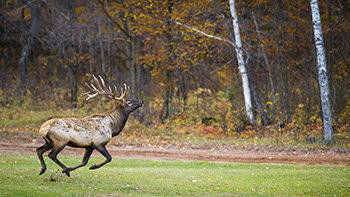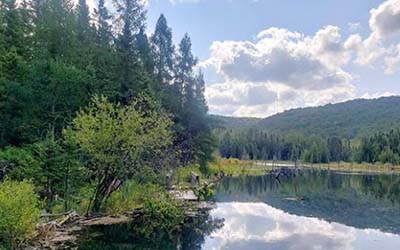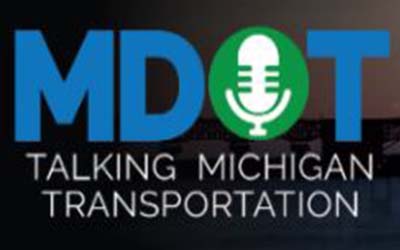Exploring the path less traveled
By RACHEL COALE
Michigan Department of Natural Resources
Deep in the forest, streams are rushing with snowmelt and tips of green are emerging from gaps between fallen leaves. Blooming time for northern Michigan’s three-petaled wild orchid, the trillium, is just around the corner. Colorful songbirds are making the long trip back to their summer homes with a season of abundance before them.
With this natural beauty in store, now is the time to start planning a getaway to the forest. Make lifetime memories while hunting for mushrooms, casting a line into a trout stream or catching sight of a free-roaming elk.
 Want to get out there? Check out our online state forest tour to inspire your trip. State forests can be found in the Upper Peninsula and northern Lower Peninsula, although there are plenty of forested areas to see in parks and recreation areas across the state as well. Want to get out there? Check out our online state forest tour to inspire your trip. State forests can be found in the Upper Peninsula and northern Lower Peninsula, although there are plenty of forested areas to see in parks and recreation areas across the state as well.
The wild character of forests comes with seclusion, so get a hard copy map or download your route before you arrive as cell service can be spotty. Once there, it’s time to unplug – the only reason you’ll need to take out your phone is to use the camera to capture memories.
State forest pathways, part of the state’s trails system, and state forest roads open to ORVs and snowmobiles are two ways to navigate state forests. Some forest roads are maintained seasonally, so do your research in advance before heading out during the winter. Road maps are updated April 1 each year.
Only a small fraction of state forest land is harvested annually, but if you come across an active timber job or planting operation, there are a few things you should know for safety.
First, stay on the trail. Logging companies must keep trails passable and post signage about upcoming activities. Let on-the-ground staff know you’re passing through if you’ll be close to the action, and don’t approach logging or cultivation equipment. |
 “A machinery operator may not be able to see or hear you while working,” said Michigan Department of Natural Resources Forest Resources Division Acting Assistant Chief Dave Lemmien. “Splinters and wood debris from cutting can sometimes fly through the air and could accidentally hit a passerby if they get too close.” “A machinery operator may not be able to see or hear you while working,” said Michigan Department of Natural Resources Forest Resources Division Acting Assistant Chief Dave Lemmien. “Splinters and wood debris from cutting can sometimes fly through the air and could accidentally hit a passerby if they get too close.”
Timber harvesters can accommodate equestrian groups if notified in advance. Ride organizers should work with the Michigan Trail Riders Association and the local forest resources unit office in the area you plan to ride.
Ready to call it a day? A state forest campground is where a day hike turns into an overnight adventure, complete with starry skies, a crackling campfire and a true wilderness experience.
“Rustic” is the best way to describe these unique campgrounds. Many of these secluded sites are hike-in or paddle-in only and are available on a first-come, first-served basis. Facilities available include basic vault toilets, fire rings and picnic tables. Drinking water comes from a hand pump, a novelty that often delights young adventurers and many adults, too.
Many state forest campgrounds are associated with bodies of water and state pathways for cool hiking opportunities right at the campgrounds.
Here are a few state forest destinations to visit, suggested by DNR staff: |
 Pigeon River Country State Forest Pigeon River Country State Forest
A must-see is the famed Pigeon River Country State Forest – “the Big Wild,” which at 109,000 acres is the largest block of undeveloped land in the northern Lower Peninsula. This forest land is home to Michigan’s elk herd and offers opportunities to camp, hike, fish and ride on horseback. Flowing trout streams, cool sinkhole lakes and a network of trails offer scenic views.
For a challenging adventure in this storied landscape, plan a hike on the High Country Pathway, a rugged, weeklong backpacking trail. Shorter trails are perfect for day hikes and picnics. An interpretive center is a great place to learn about the area’s history and stage your hike.
Jordan River Valley
It’s worth a drive off the beaten path to visit two scenic overlooks perched over the Jordan River Valley in Antrim County. Landslide Hill Scenic Overlook and Dead Man’s Hill Overlook provide spectacular views of the forest and river floodplain below, especially when autumn colors begin to turn. |
 “The Jordan River Pathway is a great area to visit with many points of interest along the trail,” said DNR forest management specialist Jason Stephens. “Maybe it’s my local bias, but this area is really special.” “The Jordan River Pathway is a great area to visit with many points of interest along the trail,” said DNR forest management specialist Jason Stephens. “Maybe it’s my local bias, but this area is really special.”
The Dead Man’s Hill Overlook, whose name recalls a tragic lumbering accident a century ago, is the trailhead for 3- and 18-mile hiking loops on the Jordan River Pathway. The 18-mile loop, part of the 4,600-mile North Country National Scenic Trail, is popular among backpackers who camp at the Pinney Bridge State Forest Campground.
In addition to excellent hiking in the valley, the Jordan River is a popular water trail for intermediate paddlers. If you don’t own a kayak or canoe, local outfitters can help plan a trip. |
 Mouth of the Two-Hearted River Mouth of the Two-Hearted River
The mighty Two-Hearted River meets Lake Superior’s icy waters along the coastline in Luce County. In this setting perfect for exploration, a walking bridge leads visitors to a rocky beach strewn with a rainbow of stones. Rockhounds can attempt to get lucky and find an agate as they catch a lakeside sunset before retiring next to the fire at a 39-campsite state forest campground. A nearby boat launch is an access point on the Lake Superior East Water Trail, and a short trip inland takes visitors to the spectacular Upper and Lower Tahquamenon Falls. |
 Sands Lake Quiet Area Sands Lake Quiet Area
In contrast to the nearby bustle of Traverse City, the Sand Lakes Quiet Area in Grand Traverse County is a serene forest designated in 1973 exclusively for nonmotorized uses including hiking, mountain biking, horseback riding, fishing and birdwatching. Five small, distinctive “marl lakes” can be found along hiking trails that ramble over 2,800 acres of rolling hills. These glacial lakes have an ethereal teal hue due to calcium carbonate content in the water. A few of the lakes are stocked with trout. Trails and lakes can be accessed starting at the Guernsey Lake State Forest Campground. |
 Big Eric’s Bridge State Forest Campground Big Eric’s Bridge State Forest Campground
In the Upper Peninsula, Big Eric’s Bridge State Forest Campground, along the banks of the Huron River in Baraga County, is a secluded destination. Visitors will enjoy hiking, camping, fishing, ORV riding and viewing nearby waterfalls, including Big Eric’s Falls, flowing over the rocky riverbed.
“It’s just a really peaceful, beautiful place,” said DNR training coordinator Jan Hebekeuser.
With a campground, road, bridge and falls named after him, who was Big Eric? Eric Erickson, a well-known local figure of an imposing stature, was Henry Ford’s lumber camp foreman more than a century ago.
Before you head out, pack the following information with you.
In the outdoors, Leave No Trace principles are the gold standard for responsible recreation, encouraging people to leave the places they love wild and in better shape than they found them.
That means packing out trash of all kinds and leaving wildflowers alone. Occasionally, you may run into something worse than a few candy wrappers – a dump site. In addition to being unsightly, piles of trash in the woods are a danger to people and wildlife. If you encounter one, report it to the Report All Poaching hotline at 1-800-292-7800 or log it with the Adopt-a-Forest Program so a team can take care of it.
Learn more about Michigan’s wonderful state forest campgrounds. |
Check out previous Showcasing the DNR stories in our archive at Michigan.gov/DNRStories. To subscribe to upcoming Showcasing articles, sign up for free email delivery at Michigan.gov/DNR.
/Note to editors: Contact: John Pepin, Showcasing the DNR series editor, at 906-250-7260. Accompanying photos and a text-only version of this story are available below for download and media use. Suggested captions follow. Credit: Michigan Department of Natural Resources, unless otherwise noted.
Text-only version of this story.
Bridge: A bridge at the mouth of the Two-Hearted River is shown in northern Luce County.
Elk: A bull elk is photographed running at the famed Pigeon River Country in the northern Lower Peninsula.
Horseback: Horseback riders out for a nice outing.
Huron: Springtime steelhead anglers are trying their luck on the Huron River at Big Eric’s Bridge in Baraga County.
Jordan: An inviting scene from the Jordan River Valley in Antrim County is shown.
Marl: A marl lake is shown from the Sand Lakes Quiet Area in Grand Traverse County.
Sand: A peaceful trail is shown from the Sand Lakes Quiet Area in Grand Traverse County.
Trilliums: Springtime brings elegant trilliums to bloom across Michigan.
Valley: A beautiful and tranquil scene from the Jordan River Valley in Antrim County is shown./
|






 Want to get out there? Check out our online
Want to get out there? Check out our online  “A machinery operator may not be able to see or hear you while working,” said Michigan Department of Natural Resources Forest Resources Division Acting Assistant Chief Dave Lemmien. “Splinters and wood debris from cutting can sometimes fly through the air and could accidentally hit a passerby if they get too close.”
“A machinery operator may not be able to see or hear you while working,” said Michigan Department of Natural Resources Forest Resources Division Acting Assistant Chief Dave Lemmien. “Splinters and wood debris from cutting can sometimes fly through the air and could accidentally hit a passerby if they get too close.”
 Pigeon River Country State Forest
Pigeon River Country State Forest
 “The Jordan River Pathway is a great area to visit with many points of interest along the trail,” said DNR forest management specialist Jason Stephens. “Maybe it’s my local bias, but this area is really special.”
“The Jordan River Pathway is a great area to visit with many points of interest along the trail,” said DNR forest management specialist Jason Stephens. “Maybe it’s my local bias, but this area is really special.”
 Mouth of the Two-Hearted River
Mouth of the Two-Hearted River
 Sands Lake Quiet Area
Sands Lake Quiet Area
 Big Eric’s Bridge State Forest Campground
Big Eric’s Bridge State Forest Campground






